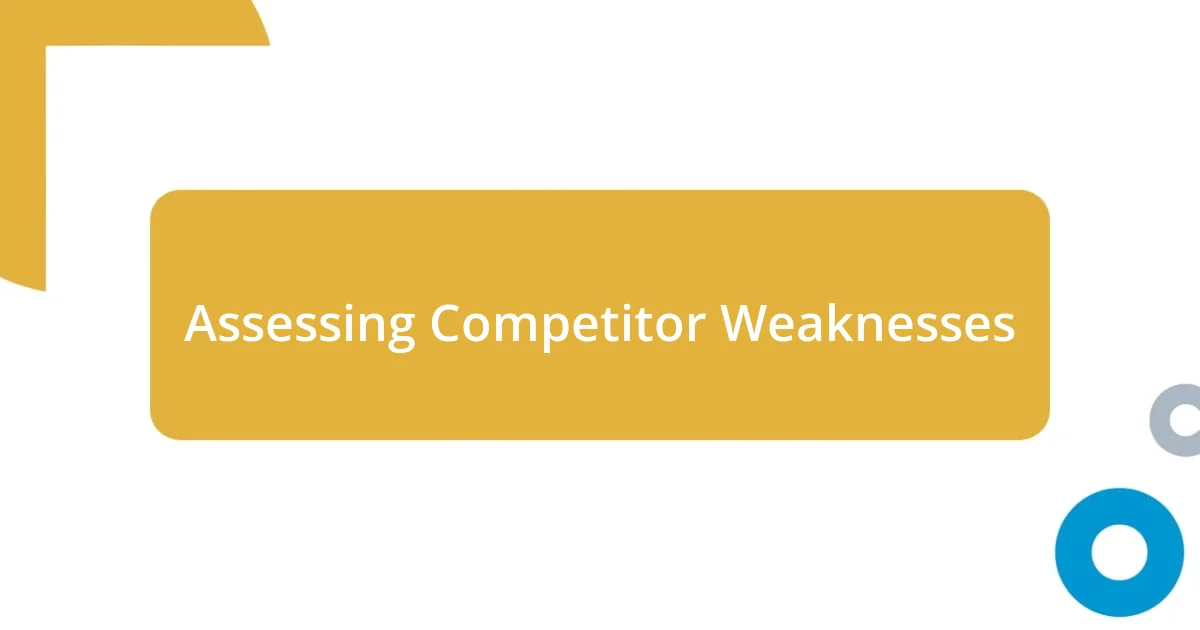Key takeaways:
- Competitor analysis reveals both strengths and weaknesses; it offers insights that can inspire innovation and enhance business strategies.
- Identifying key competitors includes assessing their market position, target audience, unique value propositions, and their strengths and weaknesses.
- Implementing findings from competitor analysis, such as improving customer service and engagement strategies, can lead to significant business growth and improved customer loyalty.

Understanding Competitor Analysis
Competitor analysis is much more than just a strategic checklist; it’s like peering into a mirror that reflects not only your competitors’ strengths but also your own weaknesses. I remember the first time I delved into this process. I was surprised to discover gaps in my own offerings that I hadn’t recognized before—gaps that my competitors were filling expertly.
When I approach competitor analysis, I can’t help but wonder: what are they doing that’s working so well? This curiosity drives me to study their marketing tactics, customer engagement strategies, and product features. It’s fascinating how sometimes a single innovation or approach can illuminate a path that I hadn’t considered, invigorating my creativity and pushing me to evolve.
I’ve often found that the emotional aspect of understanding your competitors is just as crucial as the data itself. Feeling that competitive spirit can be motivating, sparking a desire not to just match what others are doing, but to exceed it. The truth is, when you dive deep into the world of competitor analysis, you don’t just learn about them—you uncover insights that can drastically transform your own business strategies for the better.

Identifying Key Competitors
Identifying key competitors is a crucial step in understanding the landscape of your industry. I remember when I first started this process, I focused solely on the companies I considered to be my direct competitors, only to realize there were others lurking in the shadows—some small startups with innovative ideas that were shaking things up. These unexpected competitors often provide fresh insights and inspiration that can challenge your existing norms.
To pinpoint the most relevant competitors, I recommend keeping these factors in mind:
- Market Position: Are they leaders or emerging players in your market?
- Target Audience: Who are they serving, and how do those customers align with your audience?
- Strengths and Weaknesses: What do they excel at, and where do they fall short?
- Unique Value Proposition (UVP): What sets them apart in the minds of consumers?
- Innovation: How are they adapting to changes in the industry?
Taking all these aspects into account not only broadens your perspective but also guides your own strategy. I still remember the moment I recognized a smaller brand that had carved out a niche by focusing on sustainability—it inspired me to rethink my own product line, ultimately leading to a more conscious business approach.

Analyzing Competitor Strengths
When I dive into assessing my competitors’ strengths, I’m often struck by the innovative tactics they employ that I hadn’t considered before. One competitor I studied had an incredible user experience on their website, making the purchase journey seamless. Observing how they effortlessly guided customers through their offerings made me reevaluate my own site. That realization alone reinforced the importance of a polished user interface, which can significantly boost customer satisfaction and retention.
It’s important to not just jot down what companies do well but to analyze the ‘why’ behind their success. For example, I noticed another competitor excelled in community engagement through social media. Their ongoing dialogues with customers fostered a sense of loyalty that I envied. This insight prompted me to strategize new ways to build relationships with my audience, emphasizing communication beyond just selling products.
Sometimes, I find that the strengths I uncover can be about emotional connections rather than just tangible results. Identifying that a competitor had a powerful brand story made me reflect on my own narrative. I realized that sharing my journey authentically could resonate with customers on a deeper level. This process transformed not just how I view competitor strengths but also the very core of how I present my brand.
| Competitor | Strengths |
|---|---|
| Competitor A | Seamless user experience and customer journey |
| Competitor B | Strong community engagement and loyalty |
| Competitor C | Authentic brand storytelling |

Assessing Competitor Weaknesses
When I assess competitor weaknesses, I often find that it’s not just about their failures but also about opportunities for my own growth. I recall one instance where my research revealed that a major competitor had a notoriously slow shipping process which frustrated many of their customers. This insight led me to prioritize quick delivery in my own business, ultimately giving me a competitive edge. Have you ever thought about how a simple yet critical detail like shipping speed could influence customer loyalty?
Another significant weakness I’ve identified in competitors is their lack of personalization in marketing. I remember reading customer reviews where buyers expressed disappointment in receiving generic messages instead of tailored interactions. This lit a lightbulb in my head—I realized that I could create more meaningful experiences by investing in personalized communication strategies. It transformed how I approached marketing, leading to stronger connections with my audience.
Sometimes, the weaknesses lie in the products themselves. I discovered a competitor whose flagship product frequently received complaints about durability. It crystallized for me how vital it is to focus on quality and to listen to customer feedback. This ongoing process made me not just reconsider my product offerings but also reinforced my dedication to excellence as a foundational value in my business approach. Have you evaluated your competitors’ products for insights on how you can exceed customer expectations?

Uncovering Market Opportunities
Uncovering market opportunities through competitor analysis can be truly eye-opening. One day, while poring over sales data, I stumbled upon a gap in the market that a competitor was merely skimming over. Their focus was predominantly on a premium demographic, leaving middle-market consumers largely unaddressed. This sparked a lightbulb moment for me—what if I crafted a tailored offering for that underserved segment? It felt invigorating to consider how even a small shift in targeting could yield significant growth.
In another instance, I delved into customer feedback across different platforms. I noticed a pattern: many customers expressed their desire for eco-friendly packaging. Surprisingly, none of my competitors had fully embraced this trend. This revelation ignited a passion in me to explore sustainable practices. Isn’t it fascinating how listening to consumer voices can lead to a pioneering position in the market? Investing in this area not only appealed to environmentally conscious buyers but also enhanced my brand image.
I’ve also found that market opportunities often lie in product expansion. One of my competitors had been successfully selling a niche product but overlooked the potential for accessory items. This reminded me of my own experiences. When I launched my primary product, I was initially hesitant to venture into complementary goods. However, reflecting on my competitor’s missed opportunity pushed me to broaden my lineup. Have you thought about how diversifying your product range might attract new customers and keep existing ones engaged? It’s incredible how looking at competitors can inspire innovation in your own business model.

Implementing Findings into Strategy
Implementing findings from competitor analysis effectively can be a game-changer. After analyzing my competitors, I realized that they struggled with customer service, leading to a high churn rate. Inspired by this, I dedicated resources to enhancing our support system. It was remarkable to witness the immediate positive feedback from customers, who appreciated the responsiveness. Have you ever noticed how attentiveness can turn a struggling relationship into a strong loyalty bond?
I often reflect on my competitor’s marketing strategies, particularly their social media presence. They frequently posted content that lacked engagement. This insight encouraged me to adopt a more interactive approach, focusing on authentic conversations over mere posts. The results were astonishing; our follower engagement skyrocketed. I can’t help but wonder if nurturing relationships in the digital space is the secret ingredient to building a vibrant community around a brand.
Lastly, one of the most crucial lessons from my competitor analysis focused on pricing strategies. A close look revealed that many of them were price-driven and didn’t emphasize value. This prompted me to highlight the quality and benefits of my products in marketing campaigns, striking a balance between price and perceived value. I remember the satisfaction of seeing our sales increase, proving that value-centric messaging resonates deeply. Have you evaluated how your pricing strategy reflects your brand’s true worth? It’s significantly more than just numbers; it’s about sending the right message to your customers.

Measuring Success After Analysis
Measuring success after competitor analysis requires clear metrics to track progress. Personally, I set specific goals like increasing market share or improving customer satisfaction ratings, allowing me to see tangible results over time. When I first implemented this approach, it was so gratifying to watch our customer feedback scores climb—there’s just something about numbers reflecting your hard work that feels like a validation of your strategies.
I also found that customer retention rates are an interesting gauge of success. After modifying our customer service based on what I learned from my competitors, I started to see an uptick in repeat purchases. It was thrilling to realize that by focusing on the customer experience, I was not just retaining clients but also nurturing brand advocates. Have you ever experienced that exhilarating moment when you realize your efforts are genuinely resonating with your audience?
Another avenue I explored was tracking engagement across various marketing channels. By analyzing social media metrics and website traffic, I could identify what resonated with my audience. When I introduced interactive content inspired by competitor tactics, the engagement rates soared unexpectedly. Isn’t it amazing how adjusting your approach based on competitor analysis can lead to unforeseen connections with customers? That feeling of hitting the right note with your audience is incredibly rewarding, and it reaffirms the importance of continuous evaluation even after initial success.














